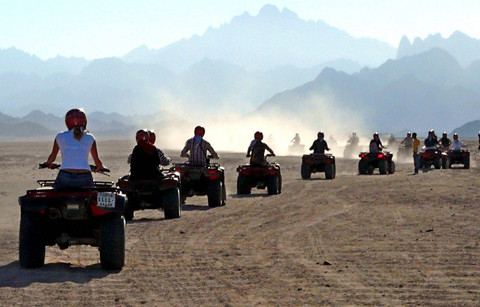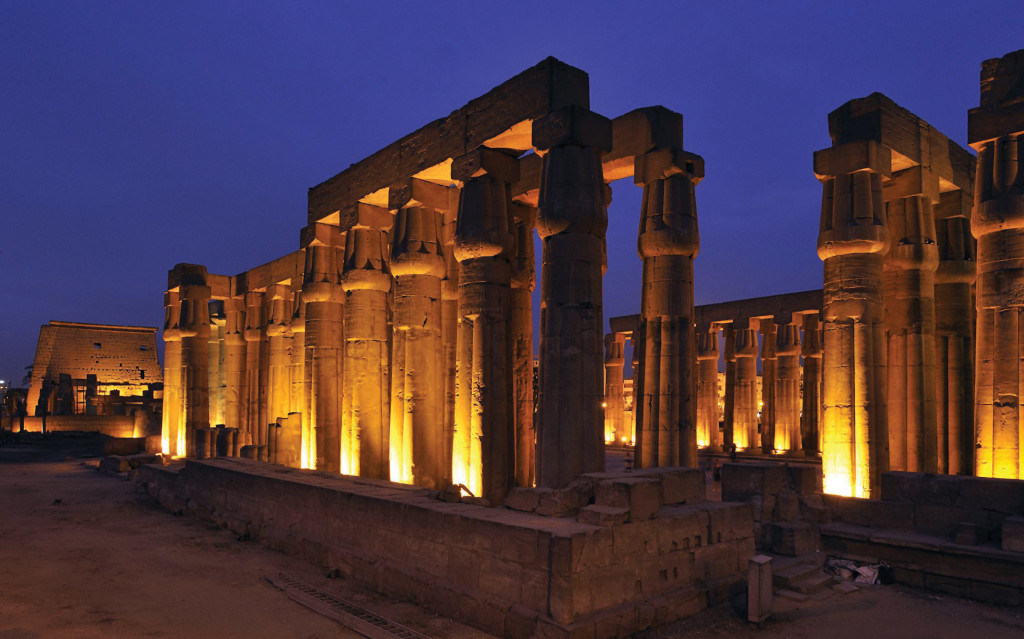Siwa Oasis is in western Egypt near the border to Libya, it is some 560km kilometers from Cairo, at a depression of 18 metres below sea level. The oasis is 82 km long and has a width varying between 2 and 20 km. The people are Berbers, and have their own language. To Siwa, there are 3 larger salt lakes, Birket Maraqi, Birket Siwa, and Birket Zaytun. Tourism has gradually given employment for some Siwans . It has beautiful oasis gardens, bathing possibilities and pharaonic temples too.
The fortress Shali is pretty much ruined to give a true image of old times.
Siwa is the westernmost of the five major oases of Egypt and can be reached by car from Baharia or from Marsa Matruh, on the Mediterranean coast. In comparison with the other oases, the most striking feature of the Siwan landscape is the presence of several salt lakes that diminish in size during the summer. The salt also impregnates the soil, creating a big problem. Mud bricks have been used for centuries to build entire village fortresses, and are called “qasr” in Arabic, such as Shali in Siwa, Qasr in Farafra, Qasr Dakhla in Dakhla and Qasr Kharga in Kharga.
In recent times, all of them have suffered mainly from the rain rather than any human devastation. Shali, in particular, has now been reduced to an impressive and dangerous ruin due to the high content of salt in its mud bricks.
Then, abruptly, you reach the edge of the scarp; at your feet lies the depression that is Siwa, averaging some 20 meters (65 feet) below sea level: a sea of green palms, a mosaic of lakes, an expanse of irrigated fields. After 300 kilometers of desert it seems a mirage.
Siwa owes its existence to an abundance of permanent fresh-water springs that permit intensive cultivation. Yet the very abundance of the water is also a serious impediment to agriculture, for without proper drainage salt would accumulate in the soil as it has in the many lakes. Siwa would still be green without human intervention, but not with crops. The land would be covered with coarse grasses and various salt-resistant desert plants, with palm groves only in favored places.
There are just under 10,000 people in the oasis today, mostly in the township of Siwa. Flint implements show that Siwa was already inhabited in paleolithic and neolithic times, but the first historical records date from the Middle and New Kingdoms of pharaonic Egypt (2050-1800 BC and 1570-1090 BC). Nonethless, it is unlikely that the pharaohs and their governors ever exercised any real control over Siwa, since there are no signs of any buildings dating from this period.
Yet Siwa was, in its way, a center of Egyptian culture, for a temple there, built to honor the ram-headed sun god Amon-Ra, housed a divine oracle whose fame, by about 700 BC, was widespread in the eastern Mediterranean. King Cambyses of Persia, son of Cyrus the Great and conqueror of Egypt, held a grudge against the oracle, probably because it had predicted that his conquests in Africa would soon falter – as indeed they did. In 524 BC Cambyses dispatched from Luxor an army of 50,000 men to destroy the Siwan oracle –
a dispersion of forces that he could ill afford on his way to capture Ethiopia. The entire army vanished without a trace, buried in the seas of sand between Siwa and the inner-Egyptian oases, and no sign of it has been found even to this day. Such an apparently supernatural victory must have enormously increased the prestige of the oracle throughout the region, though it is from the Greeks that we have most of our information. The famous Greek poet Pindar sent to Siwa a hymn of praise carved on a stone stele that has unfortunately since been lost. Lysander, the great general, tried to bribe the oracle to assist his attempt to be crowned king of Sparta. At the behest of a Siwan delegation of priests, dispatched to Greece, he was prosecuted for his impiety, but he managed to talk his way out of a conviction – probably because still more money changed hands.
The most illustrious visitor to Siwa was undoubtedly Alexander the Great. He was acclaimed pharaoh of Egypt after defeating the Persian Darius in the battle of Issus in 333 BC. In 331 he set sail from his newly-founded city of Alexandria, reached Mersa Matruh, and marched toward Siwa along the desert route that is still used today.
Though we do not know for certain, Alexander’s purpose in making the journey may have been a piece of political image-making. Each of the pharaohs of Egypt’s 28th Dynasty had traveled to Siwa to be acknowledged at the temple there as the son of Amon-Ra, the supreme god; each, thereafter, was depicted as wearing the ram’s horns of Amon on his head. Alexander wanted the same declaration of divine power to legitimize his conquest of Egypt and put himself on the same footing as the pharaohs.
The overland journey was, according to the historian Callisthenes, a dangerous one. Alexander’s party exhausted its water supply, but divine intervention produced a sudden downpour. A sandstorm caused them to lose their way, but divine intervention, Callisthenes says, sent two crows to lead them safely to Siwa. It was necessary for historians to show that kings had divine protection, so we cannot be sure that these episodes actually took place, but they were widely reported and believed at the time, and their value was all the greater because of the contrast with the fate of Cambyses’ 50,000 men.
As might be expected, conquering Alexander was received with enthusiasm at Siwa, and with pomp and ceremony to match. Dancers, musicians, priests and worshipers circled in procession in the forecourt of the temple, and thereafter Alexander requested a private session with the oracle. He was greatly pleased with the results, according to a letter to his mother, though we know neither his questions nor the oracle’s answers – yet Alexander, too, was thereafter depicted on coins wearing ram’s horns, and referred to with reverence as “Alexander of the Two Horns.” His visit was the high point of Siwa’s history.
The temple of the oracle where Alexander was received can still be seen on the hill of Aghurmi, the old capital of Siwa. It is not a great temple by the standards of the Nile Valley and it is not in good repair, but for an oasis which probably never had more than 10,000 inhabitants it is a landmark, and a symbol of fame, power and wealth quite disproportionate to such a remote spot.
Indeed, there was also a second Temple of Amon in Siwa that almost survived into the 20th century. It was blown up with gunpowder in 1897 so that its stone could be reused for the construction of a police station and a private manor.
With the coming of Roman times, oracles went out of fashion, and so did the Egyptian gods, whom the Greeks had more or less integrated into their own mythology. Auguries and the reading of animal entrails were more the Roman style. When the traveler and historian Strabo visited Egypt in 23 BC he could note that the oracle of Amon had lost almost all importance, though doubtless the god was still worshiped locally till the advent of Islam.
The next thousand years in Siwa’s history were difficult ones. Social and economic unrest followed the dissolution of Roman political power. Bedouin tribes raided the scattered settlements of the oasis and disrupted what little commerce the Siwans had. Around the year 1200 the population was reduced to 40 able-bodied men, perhaps 200 people in all. Then the whole population moved from the low ground near the temple of the oracle to a nearby hill that could be fortified. There the Siwans remained secure as the population grew steadily, as more land was cultivated, and as surplus crops were “exported” from the oasis.
By the 19th century the first European visitors, never welcomed by the population, described the whole hill as a vast beehive of buildings. In 1820, Siwa came under outside rule for the first time when it was conquered by the troops of Muhammed Ali, the Ottoman pasha of Egypt. With central rule, the defensive needs of the town were reduced and for the first time since 1200 it was permitted to build houses outside the fortifications of the town – though most people were reluctant to do so. A fierce rainstorm in 1926 demolished many houses, however, and made others unsafe, forcing people to leave. The ancient town is now almost in ruins, though its honeycomb nature is still clearly discernible.
Today, the Siwans still retain their own language, which is related to Berber as spoken in the Sahara, and on traditional feast days and at weddings the women still bring out their vast hoards of silver ornaments. But Arabic is increasingly used and Arabic expressions find their way into Siwan; traditional dress and customs are giving way as more and more of Siwa’s people are educated in Mersa Matruh and Alexandria. Recently a daily bus service began on the new road between Siwa and Mersa Matruh, and oil exploration and army encampments have led to the infusion of many outsiders. The old Siwan way of life will never be the same again.
One aspect of that way of life, though, has not changed much: Date palms and olive trees are still the twin pillars on which agriculture rests. There are at least 250,000 palm trees and at least 30,000 olive trees in the oasis; with some justification, local farmers consider their dates and olives to be among the best in the world, and indeed, records dating back to pharaonic times wax lyrical about them.
Most other Mediterranean fruits and vegetables are also grown, as well as large quantities of alfalfa for the livestock and for export. The livestock consists mainly of donkeys; the camels seen in the oasis all belong to semi-settled Bedouins.
As in all oasis, the care people lavish on the land and its crops is prodigious; watching a Siwan farmer lovingly hand-pollinate his date palms is a delight.
All of Siwa’s agricultural land consists of carefully tended gardens with elaborate watering and drainage systems connected to one or another of the natural springs. Only judicious use of irrigation and management of drainage can prevent salination and permit the gradual development of good topsoil, and each little garden represents a cumulative investment of time and effort that has grown from generation to generation. Perhaps the most impressive is a circular garden with a diameter of 100 meters (325 feet), lying in the middle of one of the salt lakes and accessible only by a narrow footpath 300 meters (975 feet) long. Modern-day Siwans freely admit their admiration for the efforts that went into its construction – efforts that would not be economically viable today.
Most of the information on Siwa available to us today stems from the “Siwan Manuscript,” begun more than 100 years ago by one Abu Musallim, a qadi, or judge, who had been educated at the al-Azhar University in Cairo. It includes a summary of information from medieval Arab chroniclers, as well as the oral traditions of Siwa itself. And in the last 10 years, Swiss social anthropologist Bettina Leopoldo has spent much time in Siwa; she hopes to publish an important monograph soon on the oasis and its people. It should be a fascinating document and, in a sense, constitute a continuation of the Siwan Manuscript into modern times.
With the changes that those modern times have brought – for better and for worse – the isolation and cultural uniqueness of Siwa have been breached, but no doubt some continuity will remain with the extraordinary past. |


